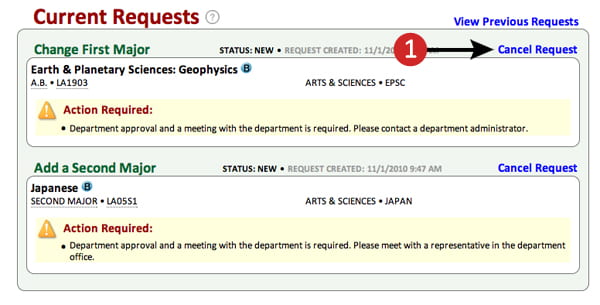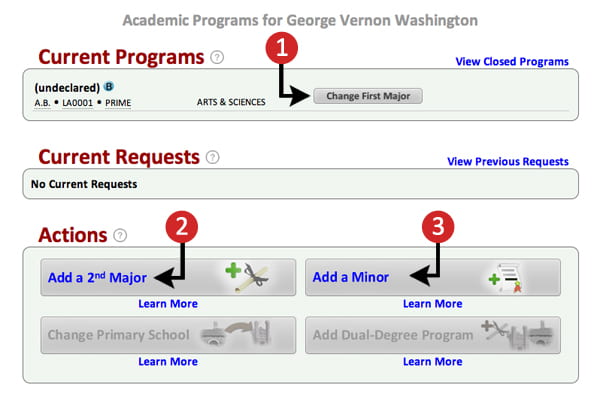Major Programs – Overview
Major Program is the term Washington University uses to refer to an academic program a student is pursuing in a particular area of study. Majors, minors, certificates, masters, doctorates, or professional program can each be referred to as a Major Program.
The Major Programs feature at WebSTAC allows you to declare majors or minors and request adjustments to your academic programs once approved by your primary college’s office. It is available to most undergraduate students. Students in other divisions should contact their Dean’s Office with questions about their programs.
Pilot Program
During the pilot phase (November 2010 into Spring 2011) a student must be activated by an administrator in order to use these features. This will normally be done when the student visits one of the participating departments.
Important Rules
- Rule of Three: Most undergraduate divisions limit the number of majors and minors a student can work towards obtaining. When the Rule of Three is referenced, it means the school abides by the rule that you may have a maximum of two majors and one minor, one major and two minors, or two separate degrees and a minor.
- Intent to Graduate: The filling of an Intent to Graduate form places the following limitations upon students using the Academic Programs menu.
- Students will not be able to change their prime major, add a second major, or swap majors after the last day before the first day of class for the semester they have filed a non-walking Intent to Graduate.
- Students can drop minors and second majors up until the Last Day to Drop with a D in the semester for which they have filed a non-walking Intent to graduate
- Students can add a minor until the last day to add courses of the semester in which they have filed a non-walking Intent to Graduate
Current Programs
The major, minor, and degree programs that you are currently enrolled in and your advisor for each are displayed here. Click to access the Current Bulletin information pertaining to the course of study selected (including course requirements and courses offered). NB: Program requirements can change from year to year. Please consult with your academic advisor to understand which bulletin covers your specific programs.
You can make changes to your academic program information online using the following functionality:
- Change: Click to change your major within the undergraduate school to which you are currently enrolled.
- Swap: If your first and second majors are in the same school and your second major can serve as a first major, you can swap them.
- Drop: Select drop to end your enrollment in a second major, minor.

Current Requests
Current and previous requests to change your academic program are shown here.
- Cancel Request: Click here to begin the cancellation process for the addition of a major, minor or second degree.

Undeclared Students
Students who have not yet declared a major or minor within the University will see the following when they visit the Academic Programs page.
- Change First Major: Click to begin the process of selecting your primary major within the University and school you are enrolled in.
- Add a 2nd Major: You can a second major in many departments across the University. Ensure you are permitted to do so for your given program(s).
- Add a Minor: Click to add a minor. Ensure that you are permitted to do so by reviewing the rules regarding academic programs.

Actions
The following are descriptions of the Action buttons.
Add 2nd Major
Students in all undergraduate programs can declare a second major if they meet their school’s requirements. The Rule of Three, which many schools follow, limits students to a maximum of one major and two minors or two majors (or degrees) and one minor within the University. No student can add a second major (or minor) in their primary department.
- Arts & Sciences: cannot violate the Rule of Three
- Business (Enrolled before Fall 2010): no limit to the number of majors or minors
- Business (Enrolled Fall 2010 and later): must follow the Rule of Three
- Sam Fox: must follow the Rule of Three. Students outside of Sam Fox cannot add a second major in the Art or Architecture schools (Dual Degree or minor only).
- Engineering: restrictions are placed on most second major programs. Check with an advisor to determine eligibility.
Add a Minor
Students in all undergraduate programs can declare minors in any other undergraduate program offered by the University. The Rule of Three, which many schools follow, limits students to a maximum of one major and two minors or two majors (or degrees) and one minor within the University. No student can add a minor (or second major) in their primary department.
- Arts & Sciences: cannot violate the Rule of Three
- Business (Enrolled before Fall 2010): no limit to the number of majors or minors
- Business (Enrolled Fall 2010 and later): must follow the Rule of Three, students have a limited choice of business minors from which to choose
- Sam Fox: must follow the Rule of Three; Art students cannot add Art minors
- Engineering: restrictions are placed on most second major programs–check with an advisor to determine eligibility.
Change Primary School (Currently Unavailable)
Contact the appropriate dean’s office for information about changing schools.
Once admitted to the university, students are permitted to request admission to other undergraduate schools at WU. This is known as an interdivision transfer. All interdivision transfers must be requested and approved by both schools prior to the fourth week of the effective semester.
To transfer from one school to another within the University, students must often meet certain requirements.
- Arts & Sciences: most students meet with a dean overseeing the inter-division transfer program
- Business: Second semester freshmen must have completed Calculus 2 with a grade of B or better. Sophomore transfers must have completed additional business course work as well.
- Engineering:
- Sam Fox: students should meet with a dean to review core studio requirements and placement
Add a Dual Degree Program (Currently Unavailable)
Contact the appropriate dean’s office for information about pursuing a second bachelor’s degree.
A student in any undergraduate division of the University may be allowed by another division to pursue a second bachelor’s degree. To do so, they must be admitted to the other degree-granting program and must fulfill the minimum degree requirements for a major in each of the two schools, as well as fulfill the distribution requirements for both schools.
Second degrees are available in: Bachelor of Arts (BA), Bachelor of Science (BS), Bachelor of Science in Business Administration (BSBA), Bachelor of Fine Arts (BFA), Bachelor of Architecture (BArch), Bachelor of Music (BMus)